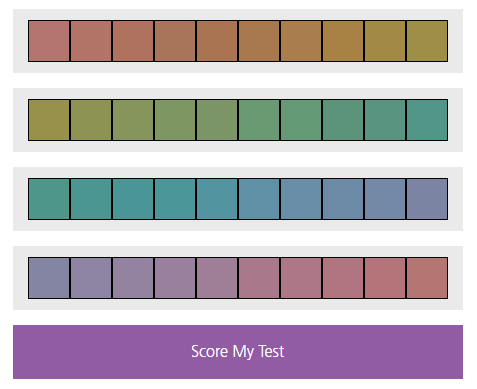
Fact: 1 in 255 women and 1 in 12 men suffer from ‘color vision deficiency’ according to the stats provided by X-Rite Photo & Video and Pantone in their newly formulated Color IQ Challenge. Pantone is known for their “products & guides for accurate communication of color” and this test may just give you the information you need to perfect your color and hue detection.
Based on the Farnsworth Munsell 100 Hue Test, this online test is designed to gauge your ‘color vision acuity’. For those of us that spend hours on end focusing on our color-calibrated monitors, post-producing and retouching images, this may be a great way for you to gauge whether or not your sense of color detection is up to par.
The lower the score the better (for once) because in this case, zero is a perfect score. The circle graph displays the regions of the color spectrum where your hue discrimination is low.
Factors that May Lead To Color Vision Deficiency
Lighting – Light plays one of the most significant roles in color perception. The color of light determines the color your brain will perceive. X-Rite & Pantone suggest to “always judge and compare color samples under controlled lighting conditions.”
Backgrounds Effects – You should always judge color in a neutrally colored environment. For photographers, having color calibrated monitors helps with any personal deficiencies we may come across. The human eye’s ability to correctly perceive the color is affected by the surrounding colors, a phenomenon known as simultaneous contrast.
Retinal Fatigue – With our culture’s heavy reliance on screen-watching, be it our smart phones or our computer monitors, we face a higher chance of retinal fatigue. “When we stare at an object for longer than a few seconds, chemicals in our eyes start to deplete and begin sending incorrect information to our brains”, so make sure you are taking breaks between post-producing batches of images as a preventative measure.
Poor Color Memory – Our brains find it extremely difficult to remember the specifics of any given color. To effectively determine slight color differences, color samples must be side-by-side.
Age – Even though age is just a number, as we grow older our color perception tends to fade. Nothing to fear, however, because color perception isn’t just an innate ability, it can be learned over time as an acquired skill. If you find yourself in a role of constant color evaluation, you may want to consider training your eyes to see past limitations.






Get Connected!